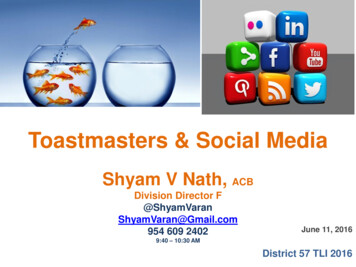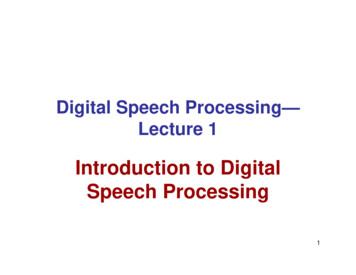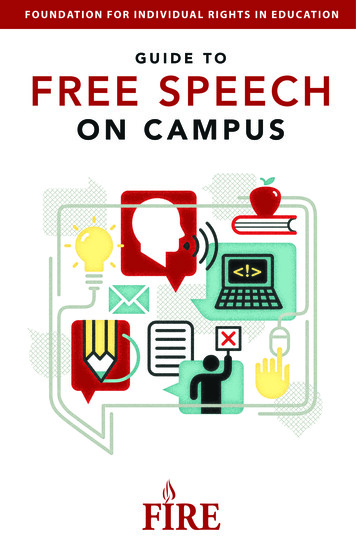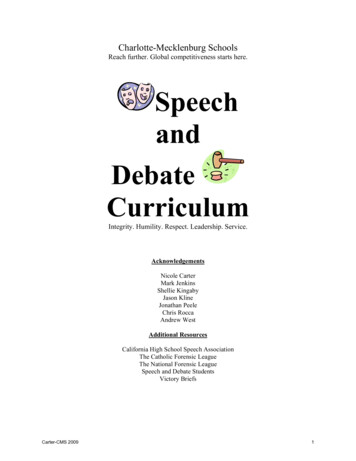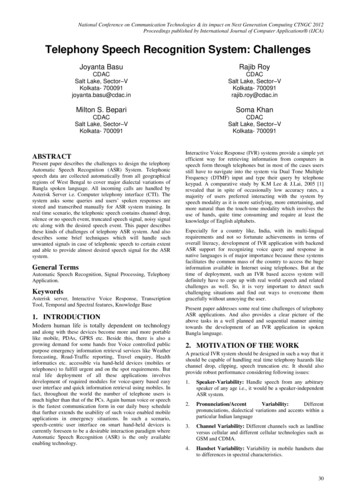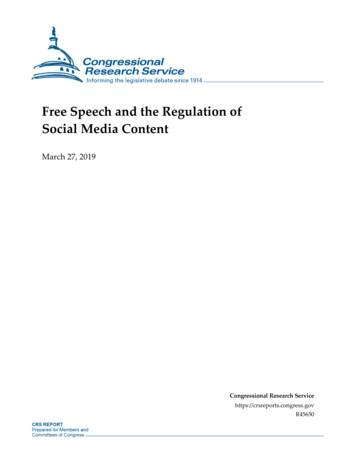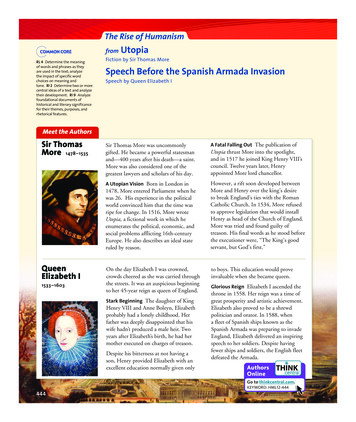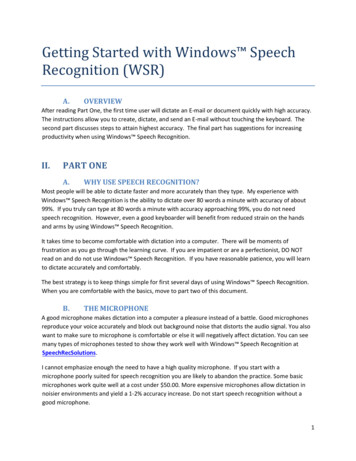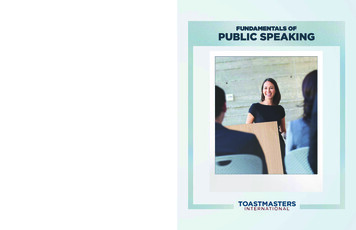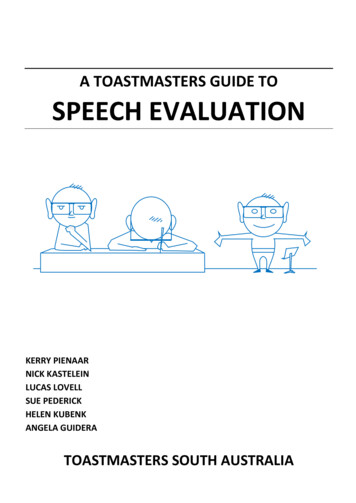
Transcription
A TOASTMASTERS GUIDE TOSPEECH EVALUATIONKERRY PIENAARNICK KASTELEINLUCAS LOVELLSUE PEDERICKHELEN KUBENKANGELA GUIDERATOASTMASTERS SOUTH AUSTRALIA
SPEECH EVALUATION December 2016This resource was prepared by a group of Toastmaster members from South Australian Toastmasters clubs: KerryPienaar (Winner of District 73 Evaluation Contest 2015, Area C12 Contest 2016), Nick Kastelein (Winner of AreaC11 Evaluation contest 2016), Lucas Lovell (Winner of District 73 Evaluation Contest 2016), Helen Kubenk DTM(Winner of Area C8 Evaluation Contest 2016), Sue Pederick (Central Division Director 2016/17) and Angela GuideraDTM. The resource was prepared to assist Toastmasters from Central Division, Toastmasters. It is intended for freedistribution and for display in its entirety on the South Australian Toastmasters Website, www.toastmastersa.org.No-one is permitted to make a profit from the distribution of this resource without prior consent of the authors.i
TOASTMASTERS SOUTH AUSTRALIAii
SPEECH EVALUATIONPREFACEI have often heard Toastmasters in South Australia (new and experienced) express that they do not volunteer toevaluate other speakers as they lack confidence in their ability to evaluate well, and many do not enjoy thechallenge.In 2015 I visited a Toastmasters club in South Africa where I participated in an evaluation coaching/mentoringexercise. This activity impressed me in its capacity to support and upskill Toastmasters in the critical tools requiredfor effective evaluation. It highlighted what I believe is missing in our clubs in South Australia. That is, support forToastmasters at the point when they may most need it - when they are preparing and delivering evaluations at ameeting. While annual workshops are very useful, weeks or months later a Toastmaster may need somewhere toturn for assistance.When I returned from South Africa, I shared my vision, now affectionately known as “KEV” – Kerry’s EvaluationVision - to work with Toastmasters in Central Division to feel more empowered in preparing and deliveringevaluations. This launched an idea for my High Performance Leadership project, to provide tools, i.e. resources,support and ideas for Toastmasters to upskill in this area. The three key steps in this project included:1. Delivering the 2015 Central Division evaluation workshop to not only share information but also to gatherinformation about what Toastmasters specifically need to assist them.2. Providing evaluation coaching for Toastmasters to use as a model at their clubs when needed. This wasalso an information gathering exercise.3. Provide a resource that all Toastmasters can use between workshops to guide and support them throughthe process. Much of this material was developed from what was learnt in steps 1 and 2.The 2015 Central Division evaluation workshop ticked all the boxes, with record attendance and rich informationto inform the next parts of the project.The evaluation coaching activities and workshops have been well received with 50% of clubs across all CentralDivision Areas in South Australia participating in this activity over the last 12 months.This resource is full of ideas, explanations, templates and examples that are suitable for Toastmasters of any level.You can choose to read the entire document or tap into specific areas of interest as you need them.I have learnt a great deal from developing this resource and have become a better speaker, evaluator and leaderas a result of the experience.The resource that you are about to read, is a culmination of over 12 months work. I have been privileged to workwith my evaluation team; a group of highly talented, intelligent, creative, fun and dedicated Toastmasters to makethis happen. It has been a highlight of my Toastmaster experience and I thank them for their inspiration,encouragement and assistance in making my vision a reality. Special thanks for Nick Kastelein for his significantcontribution to the content, editing and formatting of this resource and Lucas Lovell for providing his technicalexpertise to make this resource available online.Kerry PienaarAction TeamNick KasteleinLucas LovellSue PederickHelen KubenkAngela GuideraVanessa Ouiii
TOASTMASTERS SOUTH AUSTRALIAiv
SPEECH EVALUATIONCONTENTSPreface . iiiContents . v1.2.3.4.5.6.Introduction . 11.1Who Benefits from Evaluations? . 11.2The Aims of Evaluations . 11.3Who Can Evaluate?. 11.4Principles of Effective Evaluation . 2Preparing the Evaluation . 32.1Where to Start . 32.2Listening and Observing Critically . 32.3Prioritising Feedback . 4Structuring an Evaluation Presentation . 63.1CRC – Commend, Recommend, Commend . 63.2CRC Evaluation Template . 83.3What, How, and Why Speech Analysis Framework. 93.4What/How/Why Template . 11Speech Purpose and Objectives .124.1General Speech Purpose . 124.2Specific Speech Purpose . 124.3Determining the Speech Purpose . 144.4Speech Objectives . 14Language of Evaluations .155.1Delivering Evaluations Using Constructive Language & Manner . 155.2Alternatives to Commonly used Descriptive Words for Evaluations . 16Elements of a Speech that Can be Evaluated .176.1How to Evaluate Voice. 176.2How to Evaluate Body Language . 196.3How to Evaluate Speech Structure . 236.4How to Evaluate Speech Content . 266.5How to Evaluate Humour . 286.6How to Evaluate the Use of Visual Aids. 316.7Observe, Analyse and Commend/Recommend - General Template . 33v
TOASTMASTERS SOUTH AUSTRALIA7.8.9.10.11.Knowing the Level of the Speaker .347.1Evaluating New Speakers . 347.2Evaluating Advanced Speakers . 357.3Advanced Skill: Diagnosis . 37General Evaluations .388.1Role of the General Evaluator . 388.2Evaluation of Specific Roles . 398.3General Evaluator Template. 41Table Topics Evaluations .439.1Table Topics Evaluation Format . 439.2Common Observations for Table Topics Evaluators . 439.3Table Topics – Evaluation Templates . 45Competing in Evaluation Contests .4610.1The Criteria for Contest Evaluations. 4610.2Tips on what to do in an Evaluation Contest . 4810.3Preparation for Evaluation Contests . 48Conclusion .50vi
SPEECH EVALUATION1. INTRODUCTIONLearning how to give feedback constructively is an invaluable tool in our personal and professional lives.There are many situations where we need to give constructive feedback and we want the receiver to takethe suggestions on board without being defensive. Some examples are giving a colleague formal feedbackin the workplace, providing feedback to a service provider, or providing informal feedback to friends,family, or children. If we provide this feedback well, we are more likely to achieve a desired outcome andto support or facilitate positive change or improvement.1.1Who Benefits from Evaluations?In Toastmasters, everyone benefits from evaluations.1. The Speaker benefits – The evaluation provides a resource for improvement2. The Audience benefits – They learn from the evaluator’s advice3. The Evaluator benefits – An evaluator develops as a speaker by analysing the speeches of others“Evaluations are the fertiliser of our growth and development”–Bob Faye The value of Evaluations, Bedstone Olympics Toastmasters Club1.2The Aims of EvaluationsAn evaluator has several objectives when they deliver their evaluation. Their main focus is on the speaker.While the whole audience will benefit from the evaluation, it was the speaker who put in effort, and maybe uncertain about how their speech was received.The evaluator aims:1.3 to make speakers aware of what they do well to suggest areas for improvement in a non-threatening and nurturing manner to provide constructive and practical ideas for the speaker’s next speech to motivate speakers to improve the next time they speak to give a speaker a reason to celebrate their achievement of speaking publiclyWho Can Evaluate?It may be worth waiting until you have some experience before you begin evaluating, but don’t wait toolong! In Speechcraft courses1, the participants begin delivering evaluations after only three speeches!Speeches are aimed at the audience, so any audience member has feedback that is valuable to thespeaker. The speaker will want to hear if they were effective at communicating their message. So who canevaluate? Anyone. Don’t be afraid to start by delivering simple, subjective evaluations – we all start there.Evaluating is such an educational experience; don’t miss out.Over time, you will learn more and more about providing constructive recommendations to a speaker,because you will be able to draw increasingly on your own experience and accumulating knowledge about1Speechcraft courses are an intense public speaking training course that Toastmasters International runs for thegeneral public.1
INTRODUCTIONspeaking. However, even an inexperienced audience member adds value when they simply share theirsubjective opinion about the speech they heard.In fact, it is often refreshing for an experienced speaker to receive feedback from an inexperiencedevaluator, because the feedback is not biased by ‘textbook’ knowledge about public speaking. It isimportant not to question your ability to provide quality feedback to an advanced speaker.1.4Principles of Effective EvaluationHere are some principles of effective evaluations, which provide a snapshot of things to consider whenevaluating. These are elaborated on in more detail throughout this resource.1. Observe and listen carefully to what the speaker is saying and how they are presenting.2. Address the objectives from the speaking manual (refer to Toastmaster manual objectives).3. Use CRC (Commend Recommend Commend) method. Always start positively and finish positively(Refer to Section 3 which includes template).4. Consider the ‘what, how and why’ approach to commendations and the ‘what, why and how’approach to recommendations.5. Consider the level or capability of the speaker.6. Identify what will assist the speaker the most and prioritise your feedback accordingly.7. Analyse the speech by identifying the purpose(s) and assessing the various aspects of the speech(refer to purposes section 4).8. Use a nurturing manner and constructive language when presenting your evaluation i.e. avoidusing words and phrases with negative connotations or which imply that the speaker has donesomething wrong. Rather focus on areas for improvement with practical advice on how they canimprove (Refer section 5 on evaluating with constructive language).9. Use meaningful language when presenting your evaluation i.e. Avoid using adjectives such as‘good’ and ‘excellent’ and rather find alternatives that describe the aspect of the speech moreclearly.2
SPEECH EVALUATION2.PREPARING THE EVALUATION2.1Where to StartThe first step to evaluating is to know who you are evaluating, what speech they are delivering, and howmuch time you will have to prepare your evaluation. You can’t prepare an evaluation until you have heardthe speech, but you can prepare for an evaluation, by finding out exactly what will be happening.Here are some things you can do before you even hear a speech to prepare for your evaluation:2.2 Find out the title of the speech and the manual it is from Look up the objectives of the speech, if there are any. In Toastmasters, objectives are outlined inspeech manuals; consider reading the chapter of the manual that describes the project that youwill be evaluating. Ask the speaker if they have any personal objectives. Are there any things they are challengingthemselves with, that they are concerned about, or that they would like specific feedback on? For a Toastmasters manual speech, consider reading the feedback the speaker received fromhis/her last evaluation (Note: some people prefer not to do this so they are not biased by theprevious evaluator) Think about the different elements of a speech, as described later in this resource (refer toelements of a speech at Section 6) If you are using an evaluation template, read through the template and plan how you will use it.Several templates are included throughout this resource. Eventually you may consider developingyour own template that works well for you.Listening and Observing CriticallyOnce the speech begins, you have only the duration of the speech to make observations, so you need tospend this time constructively.Over time, you will develop a pattern for evaluating, and some ideas will just ‘jump out at you’. However,it is generally good to be systematic in finding feedback during the speech.As you gain experience and confidence, you will develop your own system and style for preparingevaluations but the following example provides one way you can listen critically to a speech:1. At the beginning, write down the speaker’s name and the speech title. You may only hear thesedetails at the start of the speech.2. Listen carefully to the speech opening.3. Write down any first impressions (i.e. Was it a strong beginning? Does the speaker appearnervous? Were you initially impressed and wanted to hear more or did you feel disengaged duringparts of the speech? Was there anything that obviously stood out that you could commend orrecommend?). Try to identify the main reason for your first impression.4. Assess the speech structure. By this time, the opening is over, and the speaker is likely to beembarking on the body of their speech. Observe whether it is progressing logically, and whethertransitions are clear. If you are able, you could attempt to write down the speech outline as youhear it – is it clear?3
PREPARING THE EVALUATION5. Assess what the speaker is saying. Listen to the sentences; are they well-constructed and fluent?Listen to the words; does the speaker use language that is easy to understand? Listen to thecontent; is the speaker making appropriate use of description, imagery, examples, reasoning andlogic, or humour to get their message across clearly?6. Assess their body language. Observe the speaker’s manner of delivery. Are they using eyecontact, facial expressions, gesturing, and stagecraft effectively?7. Assess their vocal variety. How is the speaker using their voice? Is it easy to listen to? Are thepitch, rate, volume, tone and rhythm of their voice appropriate for communicating their message?8. Sit back and listen to the speech’s conclusion. Did it end strongly? Did you still have the sameimpressions you began with, or did anything change from your initial expectations during thespeech?If an evaluator is trying to specifically observe some aspects of the speech (such as gestures and vocalvariety) it can be easy to miss other parts of the speech, and then lose the train of the speech’s message. Ifthis happens to you, don’t worry – consider asking other audience members afterwards whether theyunderstood the speech and what they thought it was about. It can also be useful to observe members ofthe audience to find out how the speech is being received.2.3Prioritising FeedbackAfter you have listened critically to a speech, you may have identified of a lot of feedback for the speaker.If this is the case, the speaker may not need to hear all of that feedback – it could be overwhelming, andmay also be discouraging. You may choose to share your notes with the speaker or give a one on oneevaluation in a break in the meeting.The ability to prioritise feedback is one of the most important and profound skills that an evaluator canmaster – and if you achieve it, the speaker you evaluate will always walk away having learned something.Before you deliver the evaluation verbally, you need to prioritise your observations – determine a smallselection of commendations and recommendations that you will focus on (3 main commendations and 2main recommendations is generally a good number).Here are some things you can think about when selecting the feedback you will present: Always include feedback that addresses the speaker’s objectives. Provide feedback relating tothe objectives – even if only briefly in the introduction of your evaluation. The speaker needsfeedback that relates directly to what they were trying to accomplish. A good idea forToastmasters manual speeches is to check what the objectives are for the speaker’s next project.You have a good opportunity to direct them on how they may benefit further from the nextproject. Prioritise feedback that will be useful for all speeches. Some of the feedback you come up withwill be very specific to the speech you heard. For example, “When you made the third point, aboutyour grandmother, you could have printed out a picture of her to show us”. This feedback will bemore useful if it can be applied easily to the speaker’s next speech. If you use feedback torecommend more specifically why this visual aid may have enhanced the speech, then therecommendations will have greater meaning e.g. it could help the audience to connect with thecharacter’s story.4
SPEECH EVALUATION Try to present a broad spectrum of feedback. Sometimes you will have five items of feedbackthat all relate to the structure and content of the speech. You could present only these items, butit would be better to also provide the speaker feedback on their delivery (e.g. body language andvoice) so they have a broad spectrum of feedback.5
STRUCTURING AN EVALUATION PRESENTATION3.STRUCTURING AN EVALUATION PRESENTATIONAll evaluations are different. When you present an evaluation, it is ultimately up to you how you deliver it– you have creative license! However, the use of some well-trialled structures and frameworks can helpyou to get started.3.1CRC – Commend, Recommend, CommendA good starting point is to follow the CRC method – which stands for Commend, Recommend, Commend.This is an evaluation structure that includes all the key elements, is expressed very positively, includes amanageable amount of feedback for the speaker, and should fit within the 3 minute timeframe thatevaluations are generally provided (some Toastmasters clubs provide 4 minutes to evaluate long oradvanced speeches). The CRC method has sometimes been described as ‘the sandwich method’. Thebread represents the commendations and provides a solid foundation for the speaker and acknowledgestheir strengths. The filling of the sandwich represents the recommendations which are the ‘meaty’ part ofthe evaluation where the speaker learns how they can improve and build on their strengths.The CRC structure is as described below. Approximate times for each part of the evaluation are includedas a guide only, and will vary from one evaluation to another and from one evaluator to anotherdepending on their style and the type of speech that you are evaluating.Evaluation Opening (30 seconds)a. Say who you are evaluating and what the title of their speech wasb. For a Toastmasters manual speech, remind everyone briefly of the project objectives.c. Identify the purpose of their speech, as you perceived it.d. Provide an overview statement of how you perceived the speech, and whether it achievedits purpose.Evaluation Body:e. 2 Commendations (50 seconds)f.2 Recommendations (70 seconds)g. 1 Commendation (15 seconds)Evaluation Conclusion: (15 seconds)h. Summarise the 5 points in the body of the speechi.Close with a positive remark to the speakerIn a 3 minute time slot for evaluation, then aim to begin recommendations before or by the white light (2minutes), and begin your last commendation once you see the orange light (2 ½ minutes).6
SPEECH EVALUATIONExample 1Example 1: Complete evaluation using the CRC structureEvaluation introductionPeter’s speech entitled ‘Taken for Granted’ informed us about the energy industry andhow we take for granted where electricity comes from. He was addressing project five inthe Competent Communicator manual; to use his voice to convey his message effectively.Peter achieved his purpose with a very engaging, humorous documentary styleinformative speech, and a strong clear voice.Commendation 1Peter used a logical structure. He began with a personal anecdote and reminded us ofhow relevant the topic is to us, so we were inclined to listen. The speech body was clearlysignposted and developed logically to the conclusion, which inspired us to have somerespect for the era we live in and the technology that underpins it.Commendation 2Peter uses a significant pitch range and projects his voice well, so he is easily heard, butalso gives the impression of a confident and authoritative speaker.Recommendation 1Today, Peter needed to refer to notes for specific facts and statistics. As a result, he spentall of the speech standing at the lectern which impacted on the effectiveness of hisdelivery. Planning for movement with purpose could have made the speech moredynamic and hence more memorable. Peter could also develop a strategy for managinghis notes e.g. he could have used PowerPoint, or just walked back to the lectern when heneeded them.Recommendation 2Another thing that I would recommend for Peter is to be very careful about using ‘jargon’that is specific to the energy industry. With technical speeches, it is important to beaware of the knowledge level of the audience, and either explain the meaning of ‘jargon’words used, or find alternative non-technical words.Commendation 3What I enjoyed most about the speech was Peter’s natural rhythm for humour, whichwas evidence by the way everyone laughed.SummaryPeter clearly met his objective of vocal variety with his very clear, loud and modulatedvoice. His structure was well-crafted to deliver an informative speech and his humouradded something special.If Peter develops his stage-craft and avoids jargon, then future technical speeches will beeven more effective and enjoyable.Well done, Peter.7
STRUCTURING AN EVALUATION PRESENTATION3.2CRC Evaluation TemplateSpeech Title:Speaker’s Name:Date:Manual Project:Introduction – Refer to manual objectives and identify the speaker’s purposeCommendation 1:What, How, Why important/effective:Commendation 2/3:What, How, Why important/effective:Recommendation 1:What can speaker improve, Why important, How to change/improveRecommendation 2:What can speaker improve, Why important, How to change/improveCommendation 3/4:What, How, Why important/effectiveSummary – Briefly go over main points for speaker and end positively8
SPEECH EVALUATION3.3What, How, and Why Speech Analysis FrameworkThorough feedback tells the recipient three things: What the speaker did (or what the speaker could have done). Why it influences the effectiveness of the speech in achieving the speech’s purpose. How the speaker did it (or how the speaker could have done it).When they first begin evaluating, most evaluators usually focus on the ‘What’. We make observations andsee what ‘was’ and what ‘could have been’ in the speech.When we force ourselves to also think about the ‘Why’, we really begin to grow as evaluators andspeakers. Discovering why an item of feedback is important to the effectiveness of a speech helps us tolearn what an effective speech really looks like.The last stage, the ‘How’ completes the circle. When we think about how a speaker can implement ourfeedback, we help them learn how to deliver an effective speech.‘What, Why, How’ is also a good structure to use for items of feedback.It doesn’t always have to be done in that specific order. In fact, often it works to swap the order forcommendations: Begin by saying What could have been done, then Why is would have been effective, then finishwith How the speaker can do it.Commendations: Begin by saying What you observed, then How the speaker did it, and finish withWhy it was effective.The reason that this order can be preferred is that an evaluator wants to close on the most importantpoint (the last thing we say is what lingers in our audience’s minds). For a recommendation, the ‘How’ isthe take-away message for the speaker, so it’s good to leave them with this aspect. For a commendation,the ‘Why’ is the “buy-in” – it informs everyone why the point is important, and sometimes the evaluatormay choose to give this the important position at the end of the message.There are many examples of commendations and recommendations in this resource that demonstratehow to implement the ‘What, Why and How’. Example 5 shows a commendation with the order reversed.WhatRecommendationWhycould thespeakerhavedone?is itimportant?HowWhatCommendationdid thespeakerdo it?did youobserve?9Howcan thespeakerdo it?Whyis itimportant?
STRUCTURING AN EVALUATION PRESENTATION3.3.1Mastering the ‘How’The last step, ‘How’ is the most powerful, especially in recommendations. Of the three steps in thisstructure, presenting the ‘How’ requires the most experience and can be the most challenging, so newevaluators should not be concerned if they cannot always achieve it.The how step is the most practical, it requires putting yourself into the speaker’s shoes and thinking whatit will feel like for them to implement the idea. Ask yourself the following questions: What will it feel like for the speaker to do this?What might make this difficult for the speaker?Are there any ways that this idea could be practised?Are there any techniques that could make it easier for the speaker to put into practice thesuggested recommendation?Mastering the ‘How’ is a great goal to set for yourself, because knowing how to deliver an effective speechis more powerful than knowing what an effective speech looks like and why it is effective.10
SPEECH EVALUATION3.4What/How/Why TemplateSpeech Title:Name:Project:IntroductionAddress speech purpose and make general statement about the )CCRRCSummary1. Address and recap recommendations and commendations2. Make general statement about objectives or speech impact11
SPEECH PURPOSE AND OBJECTIVES4.SPEECH PURPOSE AND OBJECTIVESIn addition to providing feedback to the speaker on their manual and personal objectives, it is alsoimportant that the evaluator can correctly identify and understand the purpose of the speech they areevaluating. If the purpose is unclear to the evaluator then this can form an important part of therecommendations to the speaker.4.1General Speech PurposeWhy do we deliver spe
SPEECH EVALUATION 1 1. INTRODUCTION Learning how to give feedback constructively is an invaluable tool in our personal and professional lives. There are many situations where we need to give constructive feedback and we want the receiver to take
